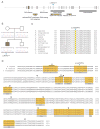Coffin-Siris syndrome: phenotypic evolution of a novel SMARCA4 mutation
- PMID: 24700502
- PMCID: PMC5671763
- DOI: 10.1002/ajmg.a.36533
Coffin-Siris syndrome: phenotypic evolution of a novel SMARCA4 mutation
Abstract
Coffin-Siris Syndrome (CSS) is an intellectual disability disorder caused by mutation of components of the SWI/SNF chromatin-remodeling complex. We describe the evolution of the phenotypic features for a male patient with CSS from birth to age 7 years and 9 months and by review of reported CSS patients, we expand the phenotype to include neonatal and infantile hypertonia and upper airway obstruction. The propositus had a novel de novo heterozygous missense mutation in exon 17 of SMARCA4 (NM_001128849.1:c.2434C>T (NP_001122321.1:p.Leu812Phe)). This is the first reported mutation within motif Ia of the SMARCA4 SNF2 domain. In summary, SMARCA4-associated CSS is a pleiotropic disorder in which the pathognomic clinical features evolve and for which the few reported individuals do not demonstrate a clear genotype-phenotype correlation.
Keywords: choanal stenosis; chromatin remodeling; expressivity; intellectual disability; scoliosis.
© 2014 Wiley Periodicals, Inc.
Conflict of interest statement
Figures



Similar articles
-
SMARCA4 inactivating mutations cause concomitant Coffin-Siris syndrome, microphthalmia and small-cell carcinoma of the ovary hypercalcaemic type.J Pathol. 2017 Sep;243(1):9-15. doi: 10.1002/path.4926. Epub 2017 Jul 25. J Pathol. 2017. PMID: 28608987 Free PMC article.
-
Coffin-Siris syndrome is a SWI/SNF complex disorder.Clin Genet. 2014 Jun;85(6):548-54. doi: 10.1111/cge.12225. Epub 2013 Jul 23. Clin Genet. 2014. PMID: 23815551
-
Coffin-Siris syndrome and the BAF complex: genotype-phenotype study in 63 patients.Hum Mutat. 2013 Nov;34(11):1519-28. doi: 10.1002/humu.22394. Epub 2013 Aug 30. Hum Mutat. 2013. PMID: 23929686
-
SMARCE1, a rare cause of Coffin-Siris Syndrome: Clinical description of three additional cases.Am J Med Genet A. 2016 Aug;170(8):1967-73. doi: 10.1002/ajmg.a.37722. Epub 2016 Jun 5. Am J Med Genet A. 2016. PMID: 27264197 Free PMC article. Review.
-
Clinical correlations of mutations affecting six components of the SWI/SNF complex: detailed description of 21 patients and a review of the literature.Am J Med Genet A. 2013 Jun;161A(6):1221-37. doi: 10.1002/ajmg.a.35933. Epub 2013 May 1. Am J Med Genet A. 2013. PMID: 23637025 Review.
Cited by
-
scRNA sequencing uncovers a TCF4-dependent transcription factor network regulating commissure development in mouse.Development. 2021 Jul 15;148(14):dev196022. doi: 10.1242/dev.196022. Epub 2021 Jul 19. Development. 2021. PMID: 34184026 Free PMC article.
-
Mutational Landscapes and Phenotypic Spectrum of SWI/SNF-Related Intellectual Disability Disorders.Front Mol Neurosci. 2018 Aug 3;11:252. doi: 10.3389/fnmol.2018.00252. eCollection 2018. Front Mol Neurosci. 2018. PMID: 30123105 Free PMC article. Review.
-
Retinal dystrophy in an individual carrying a de novo missense variant of SMARCA4.Mol Genet Genomic Med. 2019 Jun;7(6):e682. doi: 10.1002/mgg3.682. Epub 2019 Apr 11. Mol Genet Genomic Med. 2019. PMID: 30973214 Free PMC article.
-
SMARCA4 inactivating mutations cause concomitant Coffin-Siris syndrome, microphthalmia and small-cell carcinoma of the ovary hypercalcaemic type.J Pathol. 2017 Sep;243(1):9-15. doi: 10.1002/path.4926. Epub 2017 Jul 25. J Pathol. 2017. PMID: 28608987 Free PMC article.
-
SMARCA4-related Coffin-Siris syndrome in newborn: a case report and literature review.Front Pediatr. 2025 Jan 21;12:1493380. doi: 10.3389/fped.2024.1493380. eCollection 2024. Front Pediatr. 2025. PMID: 39906730 Free PMC article.
References
-
- Kingston RE, Bunker CA, Imbalzano AN. Repression and activation by multiprotein complexes that alter chromatin structure. Genes Dev. 1996;10(8):905–20. - PubMed
-
- Kosho T, Okamoto N, Ohashi H, Tsurusaki Y, Imai Y, Hibi-Ko Y, Kawame H, Homma T, Tanabe S, Kato M, Hiraki Y, Yamagata T, Yano S, Sakazume S, Ishii T, Nagai T, Ohta T, Niikawa N, Mizuno S, Kaname T, Naritomi K, Narumi Y, Wakui K, Fukushima Y, Miyatake S, Mizuguchi T, Saitsu H, Miyake N, Matsumoto N. Clinical correlations of mutations affecting six components of the SWI/SNF complex: detailed description of 21 patients and a review of the literature. Am J Med Genet A. 2013;161(6):1221–37. - PubMed
-
- Mikkelsen TS, Ku M, Jaffe DB, Issac B, Lieberman E, Giannoukos G, Alvarez P, Brockman W, Kim TK, Koche RP, Lee W, Mendenhall E, O’Donovan A, Presser A, Russ C, Xie X, Meissner A, Wernig M, Jaenisch R, Nusbaum C, Lander ES, Bernstein BE. Genome-wide maps of chromatin state in pluripotent and lineage-committed cells. Nature. 2007;448(7153):553–60. - PMC - PubMed
Publication types
MeSH terms
Substances
Supplementary concepts
Associated data
- Actions
- Actions
Grants and funding
LinkOut - more resources
Full Text Sources
Other Literature Sources
Miscellaneous

